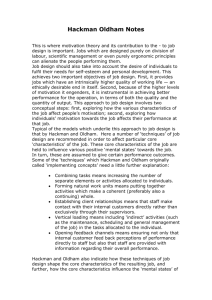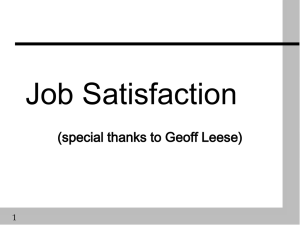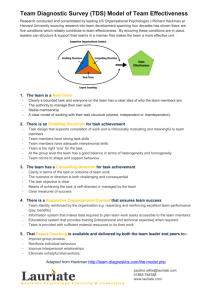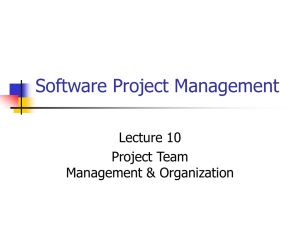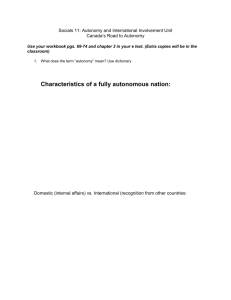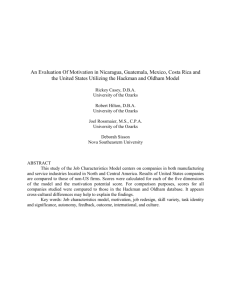Motivating by Enriching Jobs to Make Them More Interesting
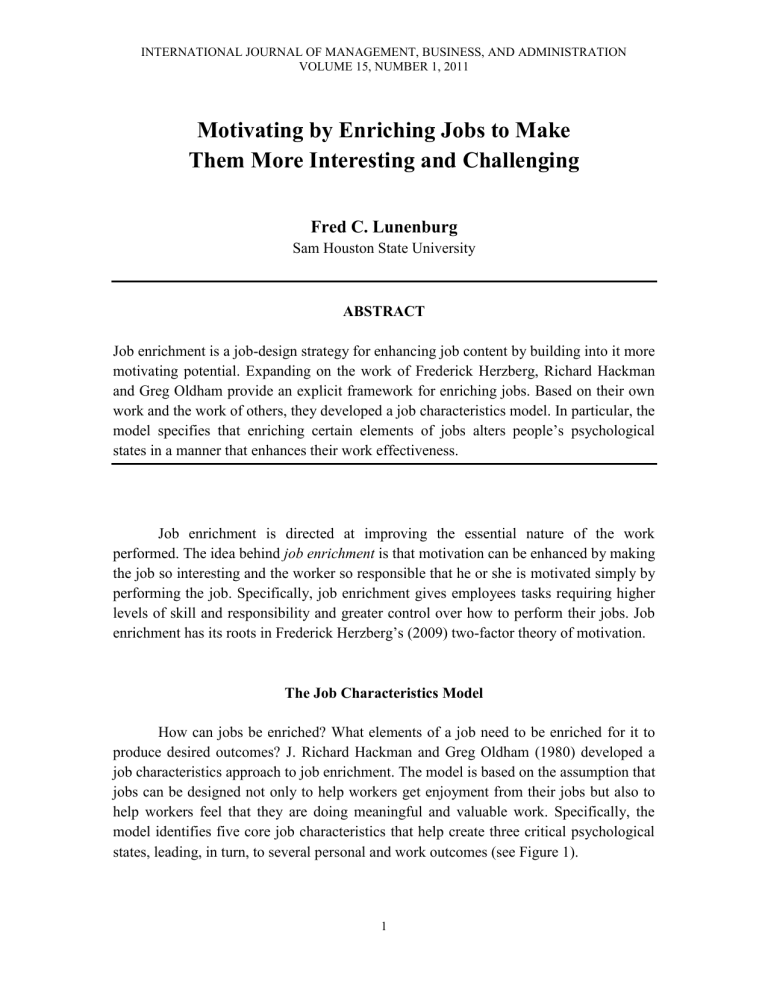
INTERNATIONAL JOURNAL OF MANAGEMENT, BUSINESS, AND ADMINISTRATION
VOLUME 15, NUMBER 1, 2011
Motivating by Enriching Jobs to Make
Them More Interesting and Challenging
Fred C. Lunenburg
Sam Houston State University
ABSTRACT
Job enrichment is a job-design strategy for enhancing job content by building into it more motivating potential. Expanding on the work of Frederick Herzberg, Richard Hackman and Greg Oldham provide an explicit framework for enriching jobs. Based on their own work and the work of others, they developed a job characteristics model. In particular, the model specifies that enriching certain elements of jobs alters people’s psychological states in a manner that enhances their work effectiveness.
Job enrichment is directed at improving the essential nature of the work performed. The idea behind job enrichment is that motivation can be enhanced by making the job so interesting and the worker so responsible that he or she is motivated simply by performing the job. Specifically, job enrichment gives employees tasks requiring higher levels of skill and responsibility and greater control over how to perform their jobs. Job enrichment has its roots in Frederick Herzberg’s (2009) two-factor theory of motivation.
The Job Characteristics Model
How can jobs be enriched? What elements of a job need to be enriched for it to produce desired outcomes? J. Richard Hackman and Greg Oldham (1980) developed a job characteristics approach to job enrichment. The model is based on the assumption that jobs can be designed not only to help workers get enjoyment from their jobs but also to help workers feel that they are doing meaningful and valuable work. Specifically, the model identifies five core job characteristics that help create three critical psychological states, leading, in turn, to several personal and work outcomes (see Figure 1).
1
INTERNATIONAL JOURNAL OF MANAGEMENT, BUSINESS, AND ADMINISTRATION
2____________________________________________________________________________________
Core Job
Characteristics
Skill variety
Task identity
Task significance
Autonomy
Critical
Psychological
States
Experienced meaningfulness of the work
Job feedback
Experienced responsibility for outcomes of the work
Knowledge of the actual results of the work activities
Moderators
Knowledge and skill
Growth-need strength
Context satisfaction
Figure 1 . Job enrichment model.
Personal and
Work Outcomes
High internal work motivation
High growth satisfaction
High general job satisfaction
High work effectiveness
Components of the Model
The five core job characteristics are skill variety, task identity, task significance, autonomy, and job feedback. Let’s examine each one of these more closely.
Skill variety.
Skill variety is the degree to which a job requires a variety of different activities and involves the use of a number of different skills and talents of the employee. Jobs that are high in skill variety are seen by employees as: more challenging because of the range of skills involved; relieve monotony that results from repetitive activity; and gives employees a greater sense of competence. For example, an administrative assistant with high skill variety may have to perform many different tasks
(e.g., schedule meetings, make airline and hotel reservations, do research, prepare written reports, and meet with customers).
Task identity.
Task identity is the degree to which a job requires completion of a
“whole” and identifiable piece of work—that is, doing a job from beginning to end with a visible outcome. When employees work on a small part of the whole, they are unable to
FRED C. LUNENBURG
____________________________________________________________________________________3 identify any finished product with their efforts. They cannot feel any sense of completion or responsibility for the whole product. However, when tasks are broadened to produce a whole product or an identifiable part of it, then task identity has been established. For example, dress designers will have high task identity if they do everything related to making the whole dress (e.g., measuring the client, selecting the fabric, cutting and sewing the dress, and altering it to fit the customer).
Task significance.
Task significance is the degree to which the job has a substantial impact on the lives of other people, whether those people are in the immediate organization or in the external environment. For example, medical researchers working on a cure for a terminal disease most likely recognize the importance of their work to society. Even more modest contributions to an organization can be recognized as being important to the extent that employees understand the role of their jobs to the overall mission of the company. The point is that employees should believe they are doing something important in their organization or society, or both.
Autonomy.
Autonomy is the degree to which the job provides substantial freedom, independence, and discretion to the individual in scheduling the work and in determining the procedures to be used in doing the work. It is considered fundamental in building a sense of responsibility in employees. Although most employees are willing to work within the broad constraints of an organization, employees want a certain degree of freedom. Autonomy has become very important to people in the workplace. For example, a salesperson is considered to be highly autonomous by scheduling his or her own work day and deciding on the most effective approach to use for each customer without supervision.
Job feedback.
Job feedback is the degree to which carrying out the work activities required by the job provides the individual with direction and clear information about the effectiveness of his or her performance. Feedback can be positive or negative, but it is best when it is balanced appropriately. Feedback should occur frequently rather than be delayed until the annual evaluation meeting. The only way employees can make adjustments in their performance is to know how they are performing now, not later.
Feedback can come directly from the job itself, or it can be provided verbally by management or other employees. For example, salespersons receive information regularly about how many contacts they make per day or week and the monetary value of sales made.
As shown in the model (Figure 1), these core job characteristics have important effects on various critical psychological states. For example, skill variety, task identity,
INTERNATIONAL JOURNAL OF MANAGEMENT, BUSINESS, AND ADMINISTRATION
4____________________________________________________________________________________ and task significance together contribute to a person’s experienced meaningfulness of the work
. Jobs that provide a great deal of autonomy are said to contribute to a person’s experienced responsibility for outcomes of the work . When they have the freedom to decide what to do and how to do it, employees feel more responsible for the results.
Finally, job feedback is said to give employees knowledge of the actual results of work activities . When a job is designed to provide employees with information about the effects of their actions in the workplace, they are better able to develop an understanding of how well they have performed—and such knowledge improves their effectiveness.
The job characteristics model indicates that the three critical psychological states affect various personal and work outcomes—namely, people’s internal work motivation, growth satisfaction, general job satisfaction, and work effectiveness. The higher the experienced meaningfulness of work; experienced responsibility for outcomes of the work; and knowledge of the actual results of work activities, the more positive the personal and work outcomes will be. When employees perform jobs that incorporate high levels of the five core job characteristics, they should feel highly motivated, be highly satisfied with their jobs, and perform work effectively.
Measuring the Scope of Each Job
Hackman and Oldham (1980) theorize that enriching certain core job characteristics alters people’s critical states in a manner that lead to several beneficial personal and work outcomes (see Figure 1). Hackman and Oldham (1976) claim that job motivation will be highest when the jobs performed rate high on the various core job characteristics. Accordingly, they recommend measuring the degree to which various job characteristics are present in each job. These job characteristics can then be changed systematically to enrich the job and increase its motivational potential. This assessment can be accomplished by using a questionnaire known as the Job Diagnostic Survey (JDS)
(Hackman & Oldham, 1975). The JDS yields an index known as the motivating potential score (MPS), which is the degree to which the job has the potential for motivating people.
The formula for this motivating potential score (MPS) is the following:
x autonomy x feedback
3
Note that the core job characteristics of skill variety, task identity, and task significance are combined and divided by 3, whereas the job characteristics of autonomy and feedback stand alone. Also, skill variety, task identity, and task significance are additive, therefore, one or two of these job characteristics could be missing or measured as zero, and the employee could still experience meaningfulness of the work. However, if either
FRED C. LUNENBURG
____________________________________________________________________________________5 autonomy or feedback were missing, the job would offer no motivating potential (MPS =
0) because of the multiplier effect.
Does the Job Characteristics Model Apply to Everyone?
Although many employees desire the additional challenge and responsibility associated with performing enriched jobs, others may not. Hackman and Oldham (1980) recognized that not everyone wants a job containing high levels of the five core job characteristics. Therefore, they incorporated this conclusion into their job characteristics model by identifying three attributes that affect how people respond to job enrichment
(see the box labeled Moderators in Figure 1).
The moderators identified in the job characteristics model influence how employees respond to enriched jobs. They include knowledge and skill, growth-need strength, and context satisfaction. These moderators have an impact on the relationship between the core job characteristics, critical psychological states, and ultimately personal and work outcomes. Therefore, leaders should consider the moderators when attempting to enrich jobs. Let’s take a closer look at each one of these moderators.
Knowledge and skill.
Employees whose capabilities fit the demands of enriched jobs are predicted to feel good about the job and perform well. Those who are inadequate or feel inadequate in this regard are likely to experience frustration, stress, and job dissatisfaction. These feelings of inadequacy may be especially intense for employees who want to do a good job but realize that they are performing poorly because they lack the necessary knowledge and skills. Thus, leaders need to assess carefully the competencies of employees whose jobs are to be enriched. Training and development programs may need to be implemented along with an enrichment program to help such employees attain the needed competencies.
Growth-need strength.
The degree to which an individual desires the opportunity for self-direction, learning, and personal accomplishment at work is called growth-need strength. This concept is essentially the same as Abraham Maslow’s (1970) esteem and self-actualization needs, Clayton Alderfer’s (1972) growth needs, and
Frederick Herzberg’s (2009) motivation factors. Employees high in growth-need strengths tend to respond favorably to enriched jobs. They experience greater job satisfaction; are highly motivated; are generally absent less; and produce better quality work than employees low in growth-need strengths (Graen, Scandura, & Grean, 1986).
Context satisfaction. Context satisfaction is the degree to which employees are satisfied with various aspects of their job, such as salary, quality of supervision,
INTERNATIONAL JOURNAL OF MANAGEMENT, BUSINESS, AND ADMINISTRATION
6____________________________________________________________________________________ relationship with supervisors and co-workers, and working conditions. Contextual satisfaction is similar to Herzberg’s (2009) hygiene factors. Employees who are extremely dissatisfied with their supervision, salary and benefits, and working conditions are less likely to respond favorably to enriched jobs than are employees who are satisfied with these factors. Other contextual factors (e.g. company policy and administration, status, security, travel requirements, and group norms) also can affect employee satisfaction with their jobs.
Research Findings
Many empirical studies have been done to test the job characteristics model in a variety of work settings, including banks, insurance companies, dentist offices, corrections departments, telephone companies, manufacturing firms, government agencies, and other service organizations. Most of the studies are supportive of many of the aspects of the model (Behson, Eddy, & Lorenzet, 2000; Fried & Ferris, 1987;
Humphrey, Nahrgang, & Morgeson, 2007; Johns, Xie, & Fang, 1992; Miner, 1980;
Zaccaro & Stone, 1988). Research consistently demonstrates a relationship between core job characteristics and job satisfaction (Judge, 2003; Judge, Parker, Colbert, Heller, &
Ilies, 2002; Loher, Noe, Moeller, & Fitzgerald, 1985; Saavedra & Kwun, 2000). Along with higher job satisfaction and motivation, employees performing enriched jobs usually experience lower absenteeism and turnover (Fried & Ferris, 1987; Griffith, Horn, &
Gaertner, 2000; Rentsch & Steel, 1998; Spector & Jex, 1991).
Efforts by automobile companies such as Volvo to improve productivity and satisfaction through job enrichment have emphasized autonomy and feedback. Relatively less emphasis was placed on skill variety, task identity, and task significance (Kopelman,
1985). Managers in the Torslanda and Kalmar, Sweden car assembly plants found it easier to provide individuals with greater responsibility for the total task (autonomy) and increased feedback than to change the essential nature of the task itself (Engstrom &
Medbo, 1994; Gladwin, 2001; Larson, 1998; Lewis, 2001; Van der Vegt, Emans, & Van de Vliert, 1998). Consistent with this finding, several Fortune 500 companies now provide their employees with a variety of work schedule opportunities, such as flexible hours, compressed workweeks, and working from home (Levering & Moskowitz, 2005;
Levering & Moskowitz, 2007). Research supports this investment, as autonomy has been found to be positively related to job performance and functional work behaviors (Fuller,
Marler, & Hester, 2006; Parker, Williams, & Turner, 2006).
One outcome predicted by the job characteristics model that did not produce consistent results was job performance, particularly quantity of output in complex types of jobs. For example, one study indicated that job enrichment works better in less
FRED C. LUNENBURG
____________________________________________________________________________________7 complex organizations (small firms) (Kelley, 1990). Nevertheless, managers are likely to find increases in the quality of job performance after a job enrichment intervention, providing the reward system already satisfies lower-level needs (Kopelman, 1985).
Specifically, managers cannot expect employees with relatively low growth needs to respond the same as those with relatively high growth needs (Dean & Snell, 1991;
Fiorelli & Feller, 1994; Graen, Scandura, & Graen, 1986; Snell & Dean, 1994).
Furthermore, recent research has demonstrated that for simple types of jobs, one job characteristic, task significance, does have a positive effect on job performance (Grant,
2008).
Managerial Applications
The job characteristics model specifies ways in which jobs can be enriched to enhance their motivating potential (Hackman, 1976). Five widely used approaches include: vertical loading, natural grouping, formation of natural teams, opening feedback channels, and establishing client relationships (Greenberg, 2011; Hellriegal & Slocum,
2011; Robbins & Judge, 2011).
Vertical Loading
Loading a job vertically involves giving employees responsibilities and tasks that were formerly reserved for managers. Specifically, vertical loading includes empowering employees to: set schedules, determine work methods, and decide when and how to check the quality of work produced; make their own decisions about starting and stopping work, taking breaks, and assigning priorities; and seek solutions to problems on their own, rather than immediately calling for a manager when problems arise. Giving people such responsibility for the work performed increases the level of autonomy the job offers these employees.
Natural Grouping
Rather than having several workers each perform a separate part of a whole job, have each person perform the entire job. This natural grouping increases skill variety, task identity, and task significance. For example, the work of a garage owner-operator who does electrical repairs, rebuilds engines, does bodywork, and communicates with customers provides skill variety. A cabinetmaker who designs a piece of furniture, selects the wood, builds the cabinet, and finishes it to perfection has high task identity. A nurse
INTERNATIONAL JOURNAL OF MANAGEMENT, BUSINESS, AND ADMINISTRATION
8____________________________________________________________________________________ who handles the diverse needs of patients in an intensive care unit of a hospital has high task significance.
Formation of Natural Teams
The formation of natural teams combines individual jobs into a formal unit (e.g., a division, team, or department). The criteria for such groupings include: geographic, type of business, organizational, alphabetic, and customer groups. Sales personnel might be assigned to a particular region of the state or country (geographic). Insurance claims adjusters might be assigned to teams that serve specific types of businesses, such as manufacturing, retail, or utilities (type of business). Word processors might be assigned work that originates in a particular department (organizational). File clerks could be held responsible for materials specified alphabetically (A to E, F to I, etc.) (alphabetic).
Consulting firm employees might be assigned to specific industrial or commercial accounts (customer groups).
Opening Feedback Channels
Jobs should be designed so that employees are provided with as much feedback as possible. Because people invest a substantial amount of their time at work, they want to know how well they are doing. Furthermore, they need to know often because performance varies, and the only way they can make appropriate adjustments is to know how they are performing presently. Feedback may come from the job itself or from customers, supervisors, or coworkers. For instance, salespeople might be encouraged to keep personal records of their own sales; keep sales/customer ratios; and establish good rapport with customers. Moreover, salespeople might be encouraged to observe and help each other with sales techniques; seek out information from their supervisors; and invite customer reactions concerning merchandise, service, and so on.
Establishing Client Relationships
The job characteristics model suggests that jobs should be designed so that the person performing the job (such as the auto mechanic) comes in contact with the recipient of the service (such as the car owner). Jobs designed in this manner will not only help the employee by providing feedback, but also provide skill variety (e.g., interacting with customers in addition to repairing cars); task significance (e.g., seeing the connection between their work and consequences for customers; and enhance autonomy (by giving people the freedom to manage their own relationships with clients).
FRED C. LUNENBURG
____________________________________________________________________________________9
Conclusion
Job enrichment is a job-design strategy for enhancing job content by building into it more motivating potential. Expanding on the work of Frederick Herzberg, Richard
Hackman and Greg Oldham provide an explicit framework for enriching jobs. Based on their own work and the work of others, they developed a job characteristics model. In particular, the model specifies that enriching certain elements of jobs alters people’s psychological states in a manner that enhances their work effectiveness.
References
Alderfer, C. P. (1972). Existence, relatedness, and growth . New York, NY: Free Press.
Behson, S. J., Eddy, E. R., & Lorenzet, S. J. (2000). The importance of the critical psychological states in the job characteristics model: A meta-analytic and structural equations modeling examination. Current Research in Social
Psychology, 5 (12), 170-189.
Dean, J. W., & Snell, S. A. (1991). Integrated manufacturing and job design: Moderating effects of organizational inertia. Academy of Management Journal, 34 (4)776-804.
Engstrom, T., & Medbo, L. (1994). Intra-group work patterns in final assembly of motor vehicles. International Journal of Operations and Production Management,
14 (3), 101-113.
Fried, Y., & Ferris, G. R. (1987). The validity of the job characteristics model: A review and meta-analysis. Personnel Psychology, 40 , 287-322.
Fiorelli, J., & Feller, R. (1994). Re-engineering TQM and work redesign: An integrative approach to continuous organizational excellence. Public Administration
Quarterly, 18 (1), 54-63.
Fuller, J. B., Marler, L. E., & Hester, K. (2006). Promoting felt responsibility for constructive change and proactive behavior: Exploring aspects of an elaborated model of work design. Journal of Organizational Behavior, 27 , 1089-1120.
Gladwin, L. C. (2001, April 12). Volvo delves into web-based car design.
Computerworld , 8-10.
Graen, G. B., Scandura, T. A., & Graen, M. R. (1986). A field experimental test of the moderating effects of growth need strength on productivity. Journal of Applied
Psychology, 71 , 486-491.
Grant, A. M. (2008). The significance of task significance: Job performance effects, relational mechanisms, and boundary conditions. Journal of Applied Psychology,
93 , 108-124.
INTERNATIONAL JOURNAL OF MANAGEMENT, BUSINESS, AND ADMINISTRATION
10____________________________________________________________________________________
Greenberg, J. (2011). Behavior in organizations (10 th
ed.). Upper Saddle River, NJ:
Prentice Hall.
Griffeth, R. W., Horn, P. W., & Gaertner, S. (2000). A meta-analysis of antecedents and correlates of employee turnover: Update, moderator tests, and research implications for the next millennium. Journal of Management, 26 (3), 463-488.
Hackman, J. R. (1976). Work redesign. In J. R. Hackman & J. L. Shuttle (Eds.).
Improving life at work (pp. 96-162). Santa Monica, CA: Goodyear.
Hackman, J. R., & Oldham, G. (1975). Development of the job diagnostic survey.
Journal of Applied Psychology, 60 , 159-170.
Hackman, J. R., & Oldham, G. R. (1976). Motivation through the design of work: Test of a theory. Organizational Behavior and Human Performance, 16 , 250-279.
Hackman, J. R., & Oldham, G. R. (1980). Work redesign . Reading, MA: Addison-
Wesley.
Hellriegel, D., & Slocum, J. W. (2011). Organizational behavior (13 th
ed.). Mason, OH:
South-Western Cengage Learning.
Herzberg, F. (2009). One more time: How do you motivate employees?
Cambridge, MA:
Harvard Business School Press.
Humphrey, S. E., Nahrgang, J. D., & Morgeson, F. P. (2007). Integrating motivational, social, and contextual work design features: A meta-analytic summary and theoretical extension of the work design literature. Journal of Applied Psychology,
92 (5), 1332-1356.
Johns, G., Xie, J. L., & Fang, Y. (1992). Mediating and moderating effects in job design.
Journal of Management, 18 , 657-676.
Judge, T. A. (2003). Promote job satisfaction through mental challenge. In E. A. Locke
(Ed.), Handbook of principles of organizational behavior (pp. 75-89). Hoboken,
NJ: Wiley-Blackwell.
Judge, T. A., Parker, S. K., Colbert, A. E., Heller, D., & Ilies, R. (2002). A cross-cultural review. In N. Anderson & D. S. Ones (Eds.), Handbook of industrial, work and organizational psychology , Vol. 2 (pp. 25-52). Thousand Oaks, CA: Sage.
Kelley, M. R. (1990). New process technology, job design, and work organization: A contingency model. American Sociological Review, 55 (2), 191-208.
Kopelman, R. E. (1985). Job redesign and productivity: A review of the evidence.
National Productivity Review, 4 (3), 237-255.
Larson, M. (1998, April). Knowing more: Earlier profiles in agility. BNP Media , 48-52.
Levering, R., & Moskowitz, M. (2005, January 24). The 100 best companies to work for.
Fortune , 76.
Levering, R., & Moskowitz, M. (2007, January 22). The 100 best companies to work for.
Fortune , 94.
FRED C. LUNENBURG
____________________________________________________________________________________11
Lewis, D. (2001, April 16). Volvo turns design into collaborative activity. InternetWeek ,
54-58.
Loher, B. T., Noe, R. A., Moeller, N. L., & Fitzgerald, M. P. (1985). A meta-analysis of the relation of job characteristics to job satisfaction. Journal of Applied
Psychology, 70 (2), 280-289.
Maslow, A. H. (1970). Motivation and personality (2 nd
ed.). Reading, MA: Addison-
Wesley.
Miner, J. B. (1980). Job characteristics theory of work redesign. In J. B. Miner (Ed.),
Theories of organizational behavior (pp. 231-266.). Hinsdale, IL: Dryden Press.
Parker, S. K., Williams, H. M., & Turner, N. (2006). Modeling the antecedents of proactive behavior at work. Journal of Applied Psychology, 91 (3), 636-652.
Rentsch, J. R., & Steel, R. P. (1998). Testing the durability of job characteristics as predictors of absenteeism over a six-year period. Personnel Psychology, 51 (1),
165-190.
Robbins, S. P., & Judge, T. A. (2011). Organizational behavior (14 th
ed.). Upper Saddle
River, NJ: Prentice Hall.
Saavedra, & Kwun, S. K. (2000). Affective states in job characteristics theory. Journal of
Organizational Behavior, 21 , 131-146.
Snell, S. A., & Dean, J. W. (1994). Strategic compensation for integrated manufacturing:
The moderating effects of jobs and organizational inertia. Academy of
Management Journal, 37 (5), 1109-1140.
Spector, P. E., & Jex, S. M. (1991). Relations of job characteristics from multiple data sources with employee affect, absence, turnover intentions, and health. Journal of
Applied Psychology, 76 , 46-53.
Van der Vegt, Emans, B., & Van de Vliert, E. (1998). Motivating effects of task and outcome interdependence on work teams. Group and Organization Management,
23 (2), 124-143.
Zaccaro, S. J., & Stone, E. F. (1988). Incremental validity of an empirically based measure of job characteristics. Journal of Applied Psychology, 73 (2), 245-252.
